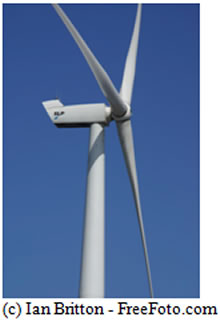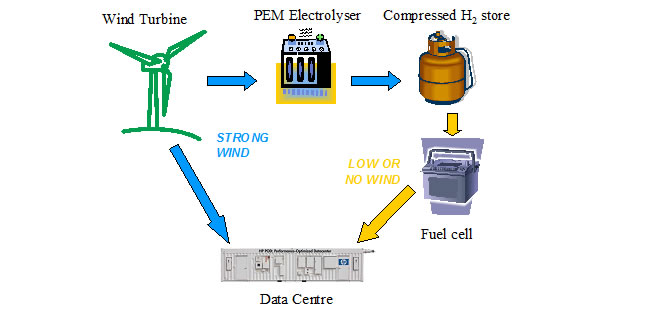Data Centres and Renewable Energy Project


Wind with hydrogen storage

Principle of Operation
When wind is blowing, a wind turbine produces electricity. Excess energy is used to produce hydrogen in an electrolyser, and the gas is stored in pressurised tanks.
When the wind is not strong enough to power the data centre, the stored hydrogen is passed through a fuel cell to generate electricity.
Technology/ Devices
- Wind turbine of 2.3MW rated capacity
- Electrolyser capacity of 665m3/ hr
- Compressor capacity of 665m3/ hr
- Hydrogen storage tanks: 900m3 at 250 bar
- Proton Exchange Membrane Fuel cells of 320 kW

Wind is plentiful all over the North of Scotland so this option could be implemented anywhere. Wind turbines are well proven and robust, and available from many manufacturers. The data centre can be sited beside the energy source so there is no need for expensive transmission lines.
In this scenario, the wind turbine size and operating characteristics were chosen to give the maximum time in operation for wind conditions in Lerwick. The turbine load factor is 39%. In an average year it produces excess electricity on 213 days; the data centre is running entirely on hydrogen on the 70 days when the turbine is standing still; and hydrogen is supplementing wind on 82 days.
Hydrogen is used continuously up to 6 days at a time. During the spring and summer there is not enough wind to build up the store after each lull, so the level in store runs down gradually. This means that there has to be enough storage capacity for 35-38 days’ operation.

Although this is close to being a balanced scenario, some excess hydrogen is produced in the winter and this could be sold to earn revenue.

Hydrogen efficiency (2): into store - electroyser & compressor: 50%
out of store - fuel cell production: 45%
Proton Exchange Membrane fuel cell is most suitable for this size of application (5).
Hydrogen characteristics (3): Density of hydrogen: 0.0899 kg/m3 at 1 bar
Energy density: 33.33 kWh/m3 at 1 bar
Calculations are in the attached spreadsheet.
Issues
- Wind is highly intermittent: turbine is standing still 20% of the time
- Round trip efficiency of hydrogen storage is only 23%, so over four units of energy must be captured for every unit of stored energy used
- Storing large quantities of compressed gas is a safety hazard
- Hydrogen technology is expensive, and hydrogen storage especially so – the cost per kWh consumed is very high
Possibilities for reducing hydrogen production and storage costs
1. Burn hydrogen in a gas engine rather than running through fuel cells, to reduce the cost. It is possible to modify a spark-ignition engine to work on hydrogen by making it more air-tight and retarding the ignition (6). However, the power density of hydrogen is about half that of petrol, and gas engines have efficiencies of only 20-25%. Even more excess energy is needed, as well as more storage capacity, so this is not in fact a cheaper option (See attached spreadsheet).
2. Over-produce electricity to reduce hydrogen production and storage facilities. With two turbines, excess electricity is produced on 250 days, or 17 % more of the time. Electroyser capacity is reduced by 1/3, and required storage capacity by 2/3. This does bring down the cost per kWh electricity consumed by about 50%; however it is still well above any economic level. Surplus electricity is generated equivalent to the annual needs of 950 households (2) which cannot easily be used unless the system is connected to the grid (See attached spreadsheet).
Conclusion
Because of the intermittent nature of the wind, and the expense of storage, it is not economically viable to power a data centre in this way, completely off-grid. Putting both the wind turbine and the data centre onto a weak grid also has its problems especially during daily peak load periods (See Grid Connection page).
A possible combination that might work technically and economically is to use wind and the grid but with a small backup hydrogen store to cover peak loading periods. Investigating this would require looking at the supply/demand balance for a wider community, domestic and industrial, and is outside the scope of this project.
References used in this page:
(1) Siemens SWT 2.3-101 brochure: http://www.energy.siemens.com/hq/en/power-generation/renewables/wind-power/wind-turbines/swt-2-3-101.htm, accessed 27 March
(2) Robertson, G, 2009: Wind-Hydrogen Community on the Isle of Lewis; MSc Thesis, University of Strathclyde
(3) Scottish Hydrogen & Fuel Cell Association: Hydrogen Properties & Safety Fact Sheet No. 1, December 2006 www.shfca.org.uk accessed 12 April 2010
(4) Scottish Hydrogen & Fuel Cell Association, Hydrogen Storage Fact Sheet No. 3, December 2006 www.shfca.org.uk accessed 12 April 2010
(5) Scottish Hydrogen & Fuel Cell Association, Fuel Cells Fact Sheet No. 5, December 2006 www.shfca.org.uk, accessed 12 April 2010
(6) White,C M; Steepera, R R; Lutza, A E, 2006; The hydrogen-fuelled internal combustion engine: a technical review; International Journal of Hydrogen Energy, Vol 31, Issue 10, pp 1292-1305